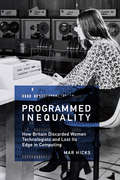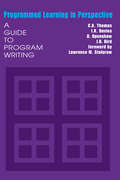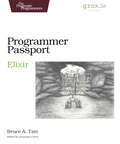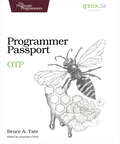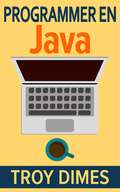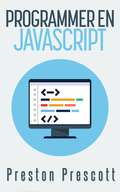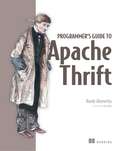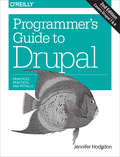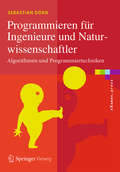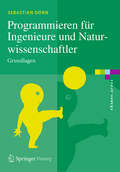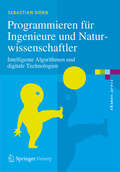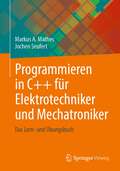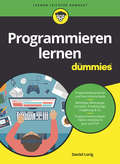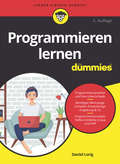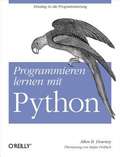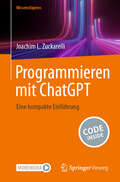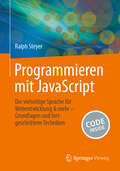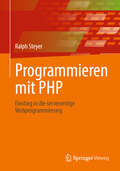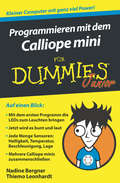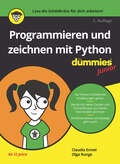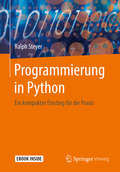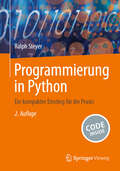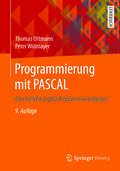- Table View
- List View
Programmed Inequality: How Britain Discarded Women Technologists and Lost Its Edge in Computing (History of Computing)
by Mar HicksHow Britain lost its early dominance in computing by systematically discriminating against its most qualified workers: women.In 1944, Britain led the world in electronic computing. By 1974, the British computer industry was all but extinct. What happened in the intervening thirty years holds lessons for all postindustrial superpowers. As Britain struggled to use technology to retain its global power, the nation's inability to manage its technical labor force hobbled its transition into the information age. In Programmed Inequality, Mar Hicks explores the story of labor feminization and gendered technocracy that undercut British efforts to computerize. That failure sprang from the government's systematic neglect of its largest trained technical workforce simply because they were women. Women were a hidden engine of growth in high technology from World War II to the 1960s. As computing experienced a gender flip, becoming male-identified in the 1960s and 1970s, labor problems grew into structural ones and gender discrimination caused the nation's largest computer user—the civil service and sprawling public sector—to make decisions that were disastrous for the British computer industry and the nation as a whole.Drawing on recently opened government files, personal interviews, and the archives of major British computer companies, Programmed Inequality takes aim at the fiction of technological meritocracy. Hicks explains why, even today, possessing technical skill is not enough to ensure that women will rise to the top in science and technology fields. Programmed Inequality shows how the disappearance of women from the field had grave macroeconomic consequences for Britain, and why the United States risks repeating those errors in the twenty-first century.
Programmed Learning in Perspective: A Guide to Program Writing
by I.K. DaviesThe method of programming outlined in this book represents a major contribution to the growing body of literature in programmed learning. It is the first book in the field to present a carefully designed, complete and integrated system for analyzing, organizing and structuring learning materials in programmed form.Application of the system is illustrated through the step-by-step construction of two short programs. Starting with the analysis of the syllabus and course content, the authors take the reader through each phase of the programming process gathering and organizing the content material, construction of the program matrix and flow diagram and finally, the writing of frames.Every teacher and trainer can benefit from the application of this method to lesson plan preparation and to classroom teaching techniques. Such a method is essential, for all those who are writing programmed materials. In a new computer age classroom environment, programmed learning can be especially beneficial.C. A. Thomas, I. K. Davies, D. Openshaw, and J. B. Bird are instructors or directors at the British Royal Air Force School of Education. They are pioneers in the application of programmed learning in Britain and are highly regarded as forward looking and creative educational research workers. Their accomplishments include, in addition to this ingenious book, the design and development of the Empirical Tutor, one of Britain's major teaching machines, and the publication of a number of technical papers in the field of programmed learning.Lawrence M. Stolurow is professor emeritus of psychological & quantitative foundations at the University of Iowa.
Programmer Passport: Elixir
by Bruce TateElixir is a functional language that crosses many boundaries. With a syntax borrowing heavily from Ruby, a runtime that is on the Erlang BEAM, a macro system like that in Lisp, and a streaming library like you might find in Haskell, Elixir takes the best features from many environments. Elixir borrows from Erlang's "Let It Crash" philosophy, and adds significant improvements with structs, first-class hygienic macros, and abstractions such as protocols. Many of these ideas were borrowed from other communities, and they make a big difference in language adoption. This book gives you a quick guided tour through the fascinating world of Elixir! Explore Elixir with the author of Seven Languages in Seven Weeks. In this fast-paced book - first published with Groxio's Programmer Passport - you'll discover how Elixir's fantastic documentation, clear error messages, and excellent tooling make it approachable and easy to work with. Learn about techniques other books skip, like writing your own Mix task, and discover several blind spots that beginning and intermediate Elixir developers encounter. Effective Elixir depends on getting the most out of the most common datatypes - explore the most important ones before using them to write modules and different kinds of functions. Learn when to choose tuples, maps, or lists in your programs, and the most effective ways to access lists. Understand the differences between maps and keyword lists. Learn the primitives Elixir uses to start multiple processes and send messages between them. You'll finish the book by dabbling with the advanced techniques of streams, sigils, and macros. Find out what Groxio customers already know. The assistance of an experienced guide will help you learn Elixir more quickly than you could without one. What You Need: You'll need Elixir version 1.12 or greater.
Programmer Passport: OTP
by Bruce TateOTP is the heart of the rapidly growing Elixir, the functional language at the heart of Phoenix and LiveView. OTP enables exciting concurrent applications with among the best reliability properties in the world. With this book, you'll learn to code systems that can detect failure and recover from it automatically using the same techniques behind the world's telecommunication systems. By plugging into OTP, your own libraries will handle concurrent requests robustly, and seamlessly integrate with other supervised Elixir and Erlang applications. If you're looking to take your next step as an Elixir developer, look no further than OTP.OTP is a library for building fault tolerant systems with self-healing properties; its services power many of the world's reliable telecom infrastructure. It also powers many of Elixir's most powerful capabilities. In this fast-paced book - first published with Groxio's Programmer Passport - you'll learn about the most important abstractions that power OTP. This approachable guide will give you a high-level understanding before diving into individual details. This understanding will tell you how the core APIs work so you'll know why Elixir programmers write code the way they do.To start, this guide will walk you through building your own basic service that works in the same way as OTP's foundational GenServer. This quick exercise will gently ease you into the way GenServers work. You'll build your own GenServer, and then quickly move on to adding the supervision services to enable the reliability and self-healing properties that make Elixir famous. Once you've done so, you'll add features like a dynamic supervisor, and use a process registry to make your program more flexible and dynamic.What You Need:You'll need Elixir version 1.12 or greater. Find out what Groxio customers already know. The assistance of an experienced guide will help you learn how to use OTP to build reliable, highly concurrent systems more quickly than you could without one.
Programmer en Java
by Victor Thivillier Troy DimesLe Java est un des langages de programmation informatique les plus largement utilisés et les plus puissants en existence aujourd'hui. Une fois que vous aurez appris à programmer en Java, vous pourrez créer des applications logicielles qui s'exécutent sur des serveurs, des ordinateurs de bureau, des tablettes, des téléphones, des lecteurs Blu-ray, et plus encore. Écrire une fois, utiliser partout! De plus, si vous souhaitez vous assurer que votre logiciel se comporte de la même manière quel que soit le système d'exploitation sur lequel il s'exécute, la philosophie de Java « Écrire une fois, utiliser partout » est pour vous. Le Java a été conçu de manière à être indépendant de la plateforme, ce qui permet de créer des applications qui s'exécutent sur divers systèmes d'exploitation, dont Windows, Mac, Solaris et Linux. Voici ce que vous apprendrez dans ce livre : *Comment préparer votre ordinateur pour la programmation en Java. (Captures d'écran inclues) *Les conventions de nommage de fichiers Java. *Comment travailler avec différents types de données, y compris les nombres entiers, les nombres flottants, les caractères et les booléens. *Que sont les variables et quand les utiliser. *Comment effectuer des opérations mathématiques en Java. *Prendre des décisions dans vos programmes, basées sur des comparaisons. *D'autres façons de contrôler le flux de vos programmes. *Comment manipuler les textes et chaînes de caractères. *Tout sur les tableaux - comment les créer, quand les utiliser, et plus encore. *Différentes façons d'effectuer plusieurs fois les mêmes actions dans vos programmes sans vous répéter. *Trois types de boucles. *Les concepts et techniques de la programmation orientée objet, y compris les classes, les modificateurs, l
Programmer en JavaScript
by Victor Thivillier Preston PrescottFatigué d'essayer d'apprendre à programmer? Prêt à vraiment apprendre comment programmer? Si vous avez essayé d'apprendre à programmer par le passé, mais n'avez pas eu beaucoup de succès, tentez le coup avec le livre « Programmer en JavaScript ». Il vous apprendra exactement ce que vous devez savoir sur le langage de script le plus largement utilisé dans le monde aujourd'hui. Vous commencerez par le début et le livre vous permettra de progresser en vous basant sur ce que vous aurez acquis au fur et à mesure. Apprenez le JavaScript une fois, utilisez-le encore et encore... Même si le JavaScript est de loin le langage de programmation côté client le plus populaire en usage aujourd'hui, il peut aussi être utilisé côté serveur. Node.js, Meteor, Wakanda, CouchDB et MongoDB ne sont que quelques exemples de frameworks avec lesquels vous serez en mesure d'utiliser JavaScript côté serveur. Le temps que vous à apprendre le JavaScript peut être doublement payant du fait que le JavaScript continue d’évoluer dans de plus en plus de domaines de l'informatique. Si vous cherchez à améliorer votre CV pour votre carrière, la maîtrise du JavaScript est une compétence inestimable. Les compétences JavaScript sont très fortement demandées et le besoin de personnes sachant programmer en JavaScript est en constante augmentation. Si vous cherchez à percer dans un domaine technique, quoi de mieux à ajouter sur votre CV que quelque chose qui peut être utilisé pratiquement partout? Vous voulez travailler sur le front-end (l’interface) de sites Web? Apprenez le JavaScript. Prêt à attaquer la programmation back-end pour les applications Web et réseau? Apprenez le JavaScript. Vous souhaitez travailler sur les technologies de bases de données les plus récentes? Apprenez le JavaScript. Apprenez le JavaScript de la bonne manière - une fois pour toutes... Peu importe si
Programmer's Guide to Apache Thrift
by William AbernethySummaryProgrammer's Guide to Apache Thrift provides comprehensive coverage of the Apache Thrift framework along with a developer's-eye view of modern distributed application architecture.Foreword by Jens Geyer.Purchase of the print book includes a free eBook in PDF, Kindle, and ePub formats from Manning Publications.About the TechnologyThrift-based distributed software systems are built out of communicating components that use different languages, protocols, and message types. Sitting between them is Thrift, which handles data serialization, transport, and service implementation. Thrift supports many client and server environments and a host of languages ranging from PHP to JavaScript, and from C++ to Go.About the BookProgrammer's Guide to Apache Thrift provides comprehensive coverage of distributed application communication using the Thrift framework. Packed with code examples and useful insight, this book presents best practices for multi-language distributed development. You'll take a guided tour through transports, protocols, IDL, and servers as you explore programs in C++, Java, and Python. You'll also learn how to work with platforms ranging from browser-based clients to enterprise servers. What's insideComplete coverage of Thrift's IDLBuilding and serializing complex user-defined typesPlug-in protocols, transports, and data compressionCreating cross-language services with RPC and messaging systemsAbout the ReaderReaders should be comfortable with a language like Python, Java, or C++ and the basics of service-oriented or microservice architectures.About the AuthorRandy Abernethy is an Apache Thrift Project Management Committee member and a partner at RX-M.Table of ContentsPART 1 - APACHE THRIFT OVERVIEWIntroduction to Apache ThriftApache Thrift architectureBuilding, testing, and debuggingPART 2 - PROGRAMMING APACHE THRIFTMoving bytes with transportsSerializing data with protocolsApache Thrift IDLUser-defined typesImplementing servicesHandling exceptionsServersPART 3 - APACHE THRIFT LANGUAGESBuilding clients and servers with C++Building clients and servers with JavaBuilding C# clients and servers with .NET Core and WindowsBuilding Node.js clients and serversApache Thrift and JavaScriptScripting Apache ThriftThrift in the enterprise
Programmer's Guide to Drupal: Principles, Practices, and Pitfalls
by Jennifer HodgdonIf you’re a web programmer, your experiences have taught you certain lessons—and only some of them apply well to Drupal. Drupal has its own set of programming principles that require a different approach, and many programmers make mistakes when relying on skills they’ve used for other projects. This book will show you which programming techniques you can use—and which you should avoid—when building web applications with this popular content management framework. Updated to cover both Drupal 7 and Drupal 8, the guidelines in this book demonstrate which programming practices conform to the "Drupal way" and which don’t. The book also serves as an excellent guide for Drupal 7 programmers looking to make the transition to Drupal 8. Get an overview of Drupal, including Drupal core and add-on modules and themesLearn Drupal’s basic programming principles, such as the ability to customize behavior and output with hooksCompare Drupal 7 and Drupal 8 programming methods, APIs, and conceptsDiscover common Drupal programming mistakes—and why hacking is one of themExplore specific areas where you can put your programming skills to workLearn about the new object-oriented Drupal 8 API, including plugins and services
Programmieren für Ingenieure und Naturwissenschaftler
by Sebastian DörnZiel des Buches ist es, Studierenden der Ingenieur- oder Naturwissenschaften die Programmierung als Schlüsselqualifikation mit zahlreichen Anwendungsmöglichkeiten vorzustellen. Großer Wert wird auf eine praxisorientierte und verständliche Darstellung gelegt. Der Autor behandelt die Anwendungsbereiche des Operations Research, der Medizinischen Informatik und der Automatisierungstechnik. Neben der Darstellung objektorientierter Entwurfsmuster werden zentrale Programmierkonzepte und fortgeschrittene Datenstrukturen vorgestellt. Suchalgorithmen, Graphen, Automaten und reguläre Sprachen werden dem Leser praxisnah vermittelt. Die Grundlagen zur Bildverarbeitung im Bereich der Bildfilterung, Registrierung und Segmentierung runden das Buch ab.
Programmieren für Ingenieure und Naturwissenschaftler: Grundlagen (eXamen.press)
by Sebastian DörnZiel des Buches ist es, Studierenden der Ingenieur- oder Naturwissenschaften die Programmierung als Schlüsselqualifikation mit zahlreichen Anwendungsmöglichkeiten vorzustellen. Die Umsetzung von Programmierkonzepten und algorithmischen Verfahren erfolgt in diesem Buch in Java. Im ersten Teil gibt der Autor eine Einführung in die Grundkonzepte von Java, im zweiten Teil werden algorithmische Verfahren aus dem Bereich der Numerik, sowie allgemeine Methoden zum Entwurf von Algorithmen vorgestellt. Im dritten Teil werden Grundlagen der objektorientierten Programmierung dargestellt sowie ein Überblick über die Erstellung von graphischen Benutzeroberflächen gegeben. Ein Kapitel zu diversen Anwendungen aus dem Bereich der Ingenieur- und Naturwissenschaften sowie Aufgaben und Lösungen in jedem Kapitel runden das Buch ab.
Programmieren für Ingenieure und Naturwissenschaftler: Intelligente Algorithmen und digitale Technologien (eXamen.press)
by Sebastian DörnZiel des Buches ist es, Ingenieuren oder Naturwissenschaftlern die Programmierung als Schlüsselqualifikation mit zahlreichen Anwendungsmöglichkeiten vorzustellen. Der Autor erläutert algorithmische Methoden, die heute hinter digitalen Produkten und Dienstleistungen stehen. Zentrale Anwendungen sind die Künstliche Intelligenz, das Data Mining, die Predictive Analytics, die Industrie 4.0 oder das Internet der Dinge. Die digitale Datenanalyse mit den zugehörigen Algorithmen ist die zentrale Grundlage vieler neuer IT-Technologien. Hierzu werden große Datenmengen verschiedenster Anwendungsfelder verarbeitet und auf gewisse Muster analysiert, um die relevanten Informationen zu extrahieren. Diese sogenannten intelligenten Verfahren sind die Basis für nahezu alle Innovationen in unserer digitalisierten Welt. Mit Hilfe dieser Art der Informationsverarbeitung werden durch die Kombination von mathematischen Modellen und algorithmischen Verfahren neue digitale Geschäftsmodelle erschaffen.
Programmieren in C++ für Elektrotechniker und Mechatroniker: Das Lern- und Übungsbuch
by Prof. Dr. Mathes Prof. Dr. SeufertDas Buch Programmieren in C++ für Elektrotechniker und Mechatroniker bietet einen Einstieg in die moderne Softwareentwicklung für Studierende der Ingenieurwissenschaften. Dabei wird ein durchgängiger Ansatz verfolgt, der, beginnend mit den Grundlagen der Programmierung, bis hin zu weiterführenden Themen, wie Hardware-nahe Programmierung, zahlreiche Themengebiete betrachtet und Studierende nicht nur für die Prüfung, sondern auch für den Arbeitsalltag vorbereitet. Da man Programmieren nur durch Üben erlernen kann, liefert das Buch einen umfangreichen Aufgabenkatalog.
Programmieren lernen für Dummies (Für Dummies)
by Daniel LorigHaben Sie auch schon mal den Wunsch verspürt, programmieren zu können? Oder wenigstens zu verstehen, wie Computer ticken, die unser Leben bestimmen? Dieses Buch führt in die Denkweise von Programmierern und die Funktionsweise von Programmen ein und zeigt Ihnen, worauf Sie beim Programmieren achten müssen: Geben Sie eindeutige Anweisungen, sichern Sie sich immer gegen alle Eventualitäten ab und kommen Sie mit den gegebenen, beschränkten Mitteln aus. Gut, dass der Computer wenigstens nicht murrt, wenn er monotone Tätigkeiten ausführen muss! Am Ende des Buches angelangt, haben Sie einen wichtigen Ausschnitt unserer Welt besser kennen gelernt und Einblicke in allgemeine Programmierkonzepte und zwei Programmiersprachen erhalten. Dann sind Sie in der Lage, fundiert zu entscheiden, ob und wie Sie Ihr Wissen weiter vertiefen wollen.
Programmieren lernen für Dummies (Für Dummies)
by Daniel LorigHaben Sie auch schon mal den Wunsch verspürt, programmieren zu können? Oder wenigstens zu verstehen, wie Computer ticken, die unser Leben bestimmen? Dieses Buch führt in die Denkweise von Programmierern und die Funktionsweise von Programmen ein und zeigt Ihnen, worauf Sie beim Programmieren achten müssen: Geben Sie eindeutige Anweisungen, sichern Sie sich immer gegen alle Eventualitäten ab und kommen Sie mit den gegebenen, beschränkten Mitteln aus. Gut, dass der Computer wenigstens nicht murrt, wenn er monotone Tätigkeiten ausführen muss! Am Ende des Buches angelangt, haben Sie einen wichtigen Ausschnitt unserer Welt besser kennen gelernt und Einblicke in allgemeine Programmierkonzepte und zwei Programmiersprachen erhalten. Dann sind Sie in der Lage, fundiert zu entscheiden, ob und wie Sie Ihr Wissen weiter vertiefen wollen.
Programmieren lernen mit Python
by Allen B. DowneyPython ist eine moderne, interpretierte, interaktive und objektorientierte Skriptsprache, vielseitig einsetzbar und sehr beliebt. Mit mathematischen Vorkenntnissen ist Python leicht erlernbar und daher die ideale Sprache für den Einstieg in die Welt des Programmierens. Das Buch führt Sie Schritt für Schritt durch die Sprache, beginnend mit grundlegenden Programmierkonzepten, über Funktionen, Syntax und Semantik, Rekursion und Datenstrukturen bis hin zum objektorientierten Design. Jenseits reiner Theorie: Jedes Kapitel enthält passende Übungen und Fallstudien, kurze Verständnistests und kleinere Projekte, an denen Sie die neu erlernten Programmierkonzepte gleich ausprobieren und festigen können. Auf diese Weise können Sie das Gelernte direkt anwenden und die jeweiligen Programmierkonzepte nachvollziehen. Lernen Sie Debugging-Techniken kennen: Am Ende jedes Kapitels finden Sie einen Abschnitt zum Thema Debugging, der Techniken zum Aufspüren und Vermeiden von Bugs sowie Warnungen vor entsprechenden Stolpersteinen in Python enthält. Starten Sie durch: Beginnen Sie mit den Grundlagen der Programmierung und den verschiedenen Programmierkonzepten, und lernen Sie, wie ein Informatiker zu programmieren.
Programmieren lernen mit Python und JavaScript: Eine praxisorientierte Einführung für Einsteiger
by Joachim L. ZuckarelliOb auf dem Computer, Tablet, Handy, im Auto oder in der Kaffeemaschine – Computerprogramme bestimmen unseren Alltag. Software wird immer wichtiger, kaum noch etwas funktioniert ohne die geheimnisvolle Macht der Algorithmen. Aber wie funktionieren Programme? Und wie entwickelt man sie? Dieses Buch vermittelt Ihnen anschaulich das Einmaleins des Programmierens. Anhand von Alltagsbeispielen lernen Sie zunächst die Grundkonzepte des Programmierens kennen, die in allen Programmiersprachen ähnlich sind. Auf Basis dieser Grundideen erlernen Sie dann auf systematische Weise und mit vielen praktischen Übungen zwei populäre und sehr nützliche Programmiersprachen, Python und JavaScript, die Sie für ein breites Spektrum an unterschiedlichen Aufgaben einsetzen können.Das Buch richtet sich an Programmieranfänger aller Altersklassen (vom Schüler bis zum Berufstätigen), die bisher keinerlei Programmiererfahrung besitzen.Zusätzliche Fragen per App: Laden Sie die Springer Nature Flashcards-App kostenlos herunter und nutzen Sie exklusives Zusatzmaterial als Printbuchkäufer, um Ihr Wissen zu prüfen.
Programmieren mit ChatGPT: Eine kompakte Einführung
by Joachim L. ZuckarelliAnwendungen künstlicher Intelligenz (KI) und vor allem Large Language Models (LLMs) sind in aller Munde und revolutionieren in vielen Bereichen die Art und Weise, wie wir arbeiten. Das gilt auch für das Programmieren und die Softwareentwicklung, wo Werkzeuge wie ChatGPT von OpenAI, wenn sie richtig eingesetzt werden, die Produktivität erheblich steigern können. Unabhängig davon, ob Sie beruflich oder privat programmieren, ob Sie Anfänger*in oder erfahrene Entwickler*in sind, ob Sie mit künstlicher Intelligenz bereits vertraut sind oder nicht, in diesem Buch lernen Sie auf kompakte, praxisorientierte Weise anhand zahlreicher Beispiele, wie Sie Werkzeuge wie ChatGPT, Claude, Gemini & Co. bei der Arbeit mit Code einsetzen können, um produktiver zu sein und Ihre Ziele schneller und müheloser zu erreichen. Darüber hinaus erfahren Sie, wie Sie einfache, eigene KI-Anwendungen auf Basis der OpenAI-API entwickeln können. Der Schwerpunkt des Buches liegt dabei auf allgemeingültigen Grundtechniken, die auch im schnelllebigen KI-Geschäft auf absehbare Zeit von Bedeutung sein werden. Der Inhalt Einführung Das Zeitalter der künstlichen Intelligenz Chancen und Risiken für das Berufsfeld des Entwicklers Teil 1 – ChatGPT & Co. verstehen Funktionsweise von ChatGPT und anderen Large Language Models Alternativen zu ChatGPT Teil 2: ChatGPT benutzen Die wichtigsten Features Tipps zur Formulierung effektiver Prompts Teil 3: Einige Anwendungsbereiche für das Programmieren mit ChatGPT: ChatGPT als Nachschlagewerk, Berater oder Tutor nutzen Code schreiben Reguläre Ausdrücke (RegEx) erzeugen und bearbeiten Test-/Beispieldaten generieren Code testen und debuggen Code formatieren, kommentieren und dokumentieren Code übersetzen/transpilieren Fremden Code verstehen Die OpenAI-API verwenden Die Produktfamilie WissensExpress bietet Ihnen Lehr-, Lern- und Sachbücher in kompakter Form. Die Bücher liefern schnell und verständlich fundiertes Wissen.
Programmieren mit JavaScript: Die vielseitige Sprache für Webentwicklung & mehr – Grundlagen und fortgeschrittene Techniken
by Ralph SteyerJavaScript hat sich mittlerweile von einer, am Anfang teils nicht ganz ernst genommenen, Skriptsprache im Browser zu einer der wichtigsten Programmiersprachen überhaupt entwickelt. Im Kern immer noch als die Sprache im Webbrowser schlechthin populär, erobert JavaScript nach und nach immer mehr Anwendungsgebiete. Bei der clientseitigen Webentwicklung gibt es im Grunde keine Alternative zu JavaScript für die Entwicklung interaktiver und dynamischer Webanwendungen. Nahezu alle Frameworks basieren zudem auf JavaScript. Aber auch zur Unterstützung vieler weiterer Arten von Software kann man JavaScript einsetzen bzw. gibt es auf JavaScript aufsetzende Frameworks. Insbesondere boomt aber die serverseitige Entwicklung mit JavaScript. Beispielsweise mit Node.js können Entwickler JavaScript auf Serverseite ausführen, was die Entwicklung von skalierbaren und leistungsstarken Webanwendungen ermöglicht. Node.js wird zudem häufig für die Erstellung von APIs, Echtzeit-Anwendungen und Microservices verwendet. Entdecken Sie in diesem Buch nun die mittlerweile fast grenzenlosen Möglichkeiten von JavaScript. Von den Grundlagen bis hin zu fortgeschrittenen Techniken werden alle Aspekte der Sprache abgedeckt. Tauchen Sie ein in die Welt von JavaScript und erweitern Sie Ihr Wissen mit praxisnahen Beispielen und bewährten Methoden. Egal, ob Sie mit JavaScript beginnen und die Grundlagen erlernen möchten, oder als erfahrene(r) Entwicklerin bzw. Entwickler das Können vertiefen wollen. Hier finden Sie das Wissen und die Werkzeuge, um Ihre JavaScript-Fähigkeiten auf das nächste Level zu bringen.
Programmieren mit PHP: Einstieg in die serverseitige Webprogrammierung
by Ralph SteyerDieses Einsteigerbuch zu PHP vermittelt grundlegende Konzepte und Techniken der Programmiersprache PHP. Leser lernen, wie man einfache Webanwendungen entwickelt, HTML mit PHP dynamisch kombiniert und Formulardaten verarbeitet. Quasi nebenbei wird damit auch ein grundlegender Einstieg in die allgemeinen Konzepte der Programmierung vermittelt. Das Buch führt durch grundlegende Syntax, Variablen, Kontrollstrukturen (wie Schleifen und Bedingungen), Funktionen sowie den Umgang mit Datenbanken (meist mit MySQL). Es bietet praktische Übungen, um Leser Schritt für Schritt in die Erstellung interaktiver Webseiten und die Verarbeitung von Benutzereingaben einzuführen. Am Ende ist der Leser in der Lage, einfache, datenbankgestützte Webanwendungen zu programmieren.
Programmieren mit dem Calliope mini für Dummies Junior (Für Dummies)
by Nadine Bergner Thiemo LeonhardtSieht er nicht schön aus - der Calliope mini? Sechseckig und voller Technik. Vielleicht arbeitest du damit in der Schule? Ja, das ist ein echter Computer. Du kannst ihn mit Programmen zum Leben erwecken. Bring seine Lämpchen zum Leuchten! Spiele Töne, komponiere Lieder! Baue eine Alarmanlage oder ein Thermometer! Bestimmt hast du ganz viele eigene Ideen. Wir helfen dir, dass du dich zuerst einmal auf dem Calliope mini zurechtfindest, der Rest geht dann fast von allein. Bestens geeignet für Kinder ab 8 Jahre.
Programmieren und zeichnen mit Python für Dummies Junior (Für Dummies)
by Claudia Ermel Olga RungeBunte Spiralen, Schneeflocken unter dem Mikroskop, 3D-Bilder? Mit diesem Buch lernst du, immer schönere Bilder mit dem Computer zu zeichnen. Es fängt ganz leicht an: Zuerst lässt du die Schildkröte, die deinen Pinsel hält, einfach nur über den Bildschirm laufen. Als nächstes bringst du ihr bei, ein Dreieck zu zeichnen. Wenn du ein Dreieck zeichnen kannst, kannst du auch ganz viele zeichnen, denn die Schildkröte nimmt dir die Arbeit ab. Dann kombinierst du Dreiecke zu Mosaiken und lässt Blumen und Bäume wachsen. Noch nicht genug? Zeichne 3D-Bilder und optische Täuschungen, animiere die Schildkröte, lasse sie Futter suchen oder steuere sie durch ein Labyrinth. Du hast noch mehr Ideen für eigene Bilder oder Spiele? Dieses Buch liefert dir die Python-Programmierbefehle dazu. Bestens geeignet für Kinder und Jugendliche ab 12 Jahre.
Programmierung in Python: Ein Kompakter Einstieg Für Die Praxis
by Ralph SteyerWer heute das Programmieren lernen möchte, kommt nicht daran vorbei, sich mit einer der beliebtesten Programmiersprachen für Einsteiger und Profis zu befassen: Python. Mit Python hat ihr Erfinder, Guido van Rossum, einen Nerv der Zeit getroffen, denn das Konzept dahinter bietet viele Ansätze, Lösungen und Vorgehensweise für Probleme, die andere Sprachen so nicht integrieren. Das Potential dieser einfachen und übersichtlichen Programmiersprache haben auch viele Universitäten erkannt, die mittlerweile in den Anfängerkursen der Informatik-bezogenen Studiengänge Python statt Java als Einsteigersprache lehren. Der klare Programmierstil legt darüber hinaus eine hervorragende Grundlage für das spätere Erlernen weiterer Sprachen. Denn Python unterstützt nicht nur die objektorientierte und aspektorientierte, sondern auch die strukturierte und funktionale Programmierung. So wird der Programmierer nicht zu einem einzigen Programmierstil gezwungen, sondern kann flexibel das am besten geeignete Paradigma für die jeweilige Aufgabe wählen. Der universelle Zugang, der es möglich macht, die Erfahrungen aus anderen Programmierkonzepten mehr oder weniger direkt weiter zu nutzen, ist ein weiterer Grund für den Erfolg von Python. Dieses Buch ist ein idealer Einstieg in die Programmierung mit Python. Ausführlich erläutert der Autor die elementaren Grundlagen, die nötig sind, um mit dieser Sprache Programme zu erstellen und zu pflegen. Daneben zeigt er, wie sich die OOP mit Python realisieren lässt und wie man Module und API-Schnittstellen integriert. Diverse weiterführende Themen wie die Erstellung grafischer Oberflächen oder der Zugriff auf Dateien und Datenbanken runden das Fachbuch ab. Einfache Beispiele veranschaulichen die grundsätzliche Anwendung der verschiedenen Techniken und machen das Buch dadurch zu einer unbedingten Empfehlung für Einsteiger und Praktiker, die die Programmierung mit Python lernen wollen.
Programmierung in Python: Ein kompakter Einstieg für die Praxis
by Ralph SteyerWer heute das Programmieren lernen möchte, kommt nicht daran vorbei, sich mit einer der beliebtesten Programmiersprachen für Einsteiger und Profis zu befassen: Python. Mit Python hat ihr Erfinder, Guido van Rossum, einen Nerv der Zeit getroffen, denn das Konzept dahinter bietet viele Ansätze, Lösungen und Vorgehensweise für Probleme, die andere Sprachen so nicht integrieren. Das Potential dieser einfachen und übersichtlichen Programmiersprache haben auch viele Universitäten erkannt, die mittlerweile in den Anfängerkursen der Informatik-bezogenen Studiengänge Python statt Java als Einsteigersprache lehren. Der klare Programmierstil legt darüber hinaus eine hervorragende Grundlage für das spätere Erlernen weiterer Sprachen. Denn Python unterstützt nicht nur die objektorientierte und aspektorientierte, sondern auch die strukturierte und funktionale Programmierung. So wird der Programmierer nicht zu einem einzigen Programmierstil gezwungen, sondern kannflexibel das am besten geeignete Paradigma für die jeweilige Aufgabe wählen. Der universelle Zugang, der es möglich macht, die Erfahrungen aus anderen Programmierkonzepten mehr oder weniger direkt weiter zu nutzen, ist ein weiterer Grund für den Erfolg von Python. Dieses Buch ist ein idealer Einstieg in die Programmierung mit Python. Ausführlich erläutert der Autor die elementaren Grundlagen, die nötig sind, um mit dieser Sprache Programme zu erstellen und zu pflegen. Daneben zeigt er, wie sich die OOP mit Python realisieren lässt und wie man Module und API-Schnittstellen integriert. Diverse weiterführende Themen wie die Erstellung grafischer Oberflächen oder der Zugriff auf Dateien und Datenbanken runden das Fachbuch ab. Einfache Beispiele veranschaulichen die grundsätzliche Anwendung der verschiedenen Techniken und machen das Buch dadurch zu einer unbedingten Empfehlung für Einsteiger und Praktiker, die die Programmierung mit Python lernen wollen.
Programmierung mit PASCAL: Eine Einführung für Programmieranfänger
by Thomas Ottmann Peter WidmayerDie Darstellung gibt eine Einführung in Pascal, die auch für Anfänger ohne Informatikkenntnisse verständlich ist. Ausgegangen wird von der Notwendigkeit, dass es nicht ausreicht, lediglich den mit dem Programmieren verbundenen Formalisierungsprozess zu erklären. Schwerpunkt des Buches ist vielmehr eine genaue Formulierung und weitgehend programmiersprachenunabhängige algorithmische Lösung von Problemen. Auf diesem Wege werden die Grundsätze des Schreibens guter Pascal-Programme illustriert.
